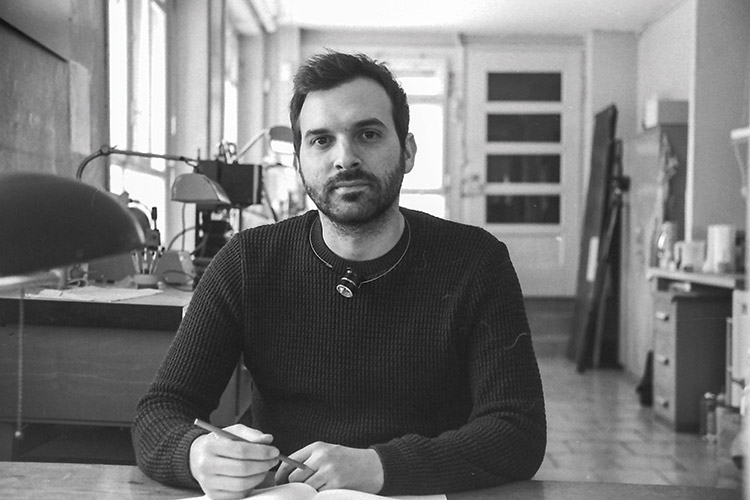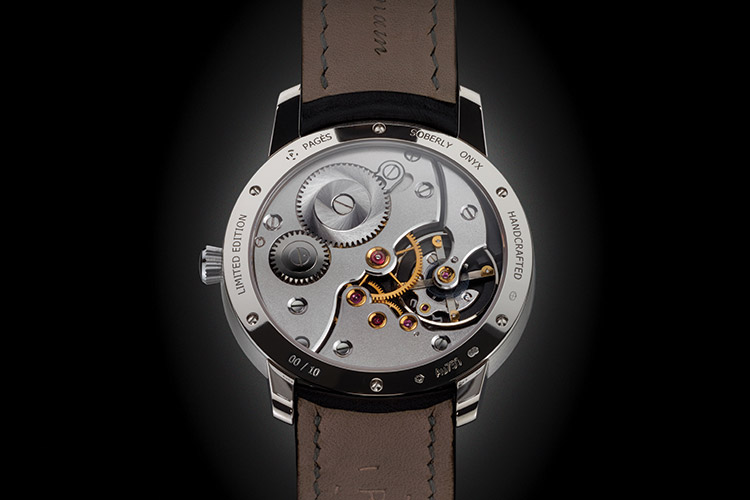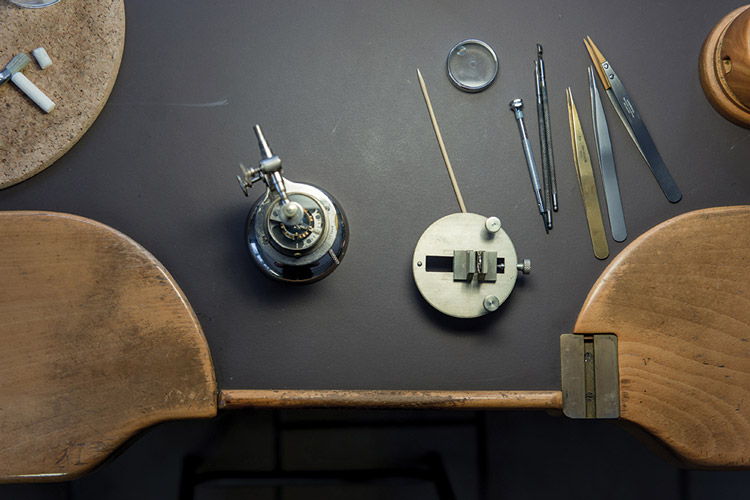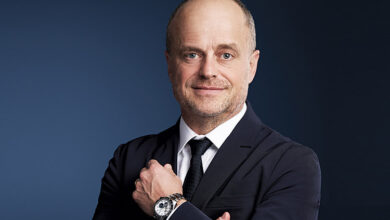
Independent Swiss watchmaker Raúl Pagès describes himself also as a designer, artist, accomplished musician, and lover of art history and 20th century design history. It is no wonder then that his creations draw their inspiration from his work on restored antique watches. This month, we focus the spotlight on Raúl Pagès, who won the 2024 Louis Vuitton Watch Prize for Independent Creatives
An early love for watches
Pagès says that he has loved watches from a very early age. “My parents are from Spain, but they came to Switzerland as children. I was born in Switzerland, and I grew up in Switzerland, very close to La Chaux-de-Fonds and this region is famous for its watchmaking industry. A lot of manufacturers and brands are based in La Chaux-de-Fonds, so lots of people here work in the watchmaking industry.”
The development of a passion
On finishing school, when it was time for Pagès to decide on a career, he was drawn to the creative arts. “I was attracted by creative jobs, as I always like to draw or create music.” A guitar player, Pagès loves soul music, jazz, and hip hop, and often performed with friends in informal settings. “After completing my schooling, I was thinking of either becoming a graphic designer or a jeweller. A friend of my older brother was at the watchmaking school of CIFOM in Le Locle and he advised me to go for a two-week trial at the school. I took his advice, and I liked it; I decided to apply to study there.”
Pagès also completed his apprenticeship there; he admits that “Watchmaking, at the beginning, was not a real passion for me. I liked it enough to learn it, but it was during my apprenticeship that my passion for watchmaking developed.” It was at this point that Pagès realised that to feed his passion for watchmaking, he needed to acquire more knowledge.
A complete watchmaker
“After finishing my basic apprenticeship as watchmaker, I continued at school to learn about restoration of antique watches, and it took an additional two years at the school. I received my diploma in 2005 and, after that, enrolled for another diploma in the watchmaking school to learn about designing complications. I learnt how to design movements on a computer with a 3D program. My goal was to be a complete watchmaker. Now, I’m very happy because I can make everything in a watch; I can create the design, conceptualise the watch, produce the components, and do the finishing of the parts. It’s important for me to be able to make everything in a watch.”
Restoration experience @ Parmigiani Fleurier
By the time he finished studying, Pagès realised that he was more attracted to the practical aspects of watchmaking. “I was very lucky to find a job at Parmigiani Fleurier’s Restoration workshop. Parmigiani has always had a restoration workshop, because Michel Parmigiani started his career as a restorer. I was very lucky because I learned so much about watchmaking there as I restored classic masterpieces from the past. During that time, we restored a number of pieces from the famed Maurice Sandoz collection as well as a large number of timepieces from the Patek Philippe Museum and private collectors. I restored a number of Breguet pocket watches and clocks, and it was a very good learning experience.
“You learn so much when working on restorations, because each piece you restore has a completely different movement. For instance, if a wheel is broken, you cannot just replace the wheel from a ready stock. There’s no stock; you have got to make the wheel by hand with traditional machines and you have to make pretty much make a brand new one. Sometimes you have to make the tool that can make the component you need, so you learn a lot. I worked at Parmigiani for six years.
Discovering another love
It was while working in Parmigiani that “I discovered automatons, which is a dying art. Nowadays, there are barely any automatons being made; they are all only the historical pieces. For me, it is a passion; I discovered these small automatons. They do not tell the time; they are just automatons.”
Going independent
It was this love of automatons that pushed Pagès to take a big risk – motivated him to leave something that was very safe, working for a company that he liked, where he was very happy – and do something crazy. “To start something that was very uncertain and carried a lot of risk – start my own company. It was, in fact, a challenge. I really loved my job at Parmigiani, but I always like to create, to design, and in restoration you cannot create. Your role there is to make the object look as close to the original as possible – to respect the origin of the piece. You cannot create something new and this left part of me unfulfilled.”
A surprising ‘Tortue’
Pagès surprised his friends and well-wishers after he established his company. Everyone expected that his first product would be a watch, but it was a tortoise automaton. “Looking back now, I think I must have been totally crazy to start a new company and make an automaton my first product. I didn’t sell it, but I cannot say it was not good because it helped exhibit my skills. I was still working at Parmigiani then, and, with Tortue, my goal was to establish a company and show my skill sets.”
“I started working on the Tortue, just because I wanted to create something. When I was working with Parmigiani, during the nights, I started to design movements on my computer because it was my passion – just to make the designs. But after some time, I realised that I had all the conceptual designs on my computer. That is the moment I said to myself, ‘OK, right now I have one complete piece designed so it is time to leave Parmigiani and produce the Tortue.’”
Pagès chose a tortoise as his first creation because of the symbolism associated with the animal – that of longevity and stability, which he hopes his brand will enjoy.
Soberly Onyx
In 2016, Pagès launched his first timepiece, Soberly Onyx. Explaining his journey, he says, “It was 2013 and I had finished the Tortue. I started with no contacts, no journalists, no retailers, no collectors. And I was thinking that I would directly sell the first piece and in the next year I would produce two automatons, and five pieces the succeeding year. Sadly, I couldn’t sell the piece, so it was quite difficult times for me because all the money I had saved during my job, I had invested in the Tortue. Because I produce all the components by hand using only traditional machines, it took me one full year to produce the Tortue. All the money I had was in the Tortue and I hadn’t sold it; it was a difficult period. Fortunately, I had continued my restoration work for private collectors, so that helped me to pay the bills. I still had the energy and in 2016 I wanted to create my own wristwatch. As I didn’t have the money to completely create my own movement, I started with a vintage Cyma ébauche (unpolished and undecorated) movement that I totally refinished.”
Soberly Onyx was limited to only 10 pieces, because Pagès was not able to source any more of this particular Cyma movement as ébauche. He had been able to get this quantity of ébauche Cyma movements from private collectors and then set to work finishing the movements. Pagès chose a vintage Cyma movement because a friend had told him about them. “It’s not very well-known, but it is a very good movement and a big size for that time. Movements from the 50s or 60s were very small, but this one is quite large and thin. I wanted to have a very elegant, thin wristwatch and could achieve that with this thin movement and case. I designed the case and the dial, while also replacing the balance wheel of the movement with balance wheel I had made.” Because Pagès likes stone dials, his first offering has an Onyx dial. “It was good, but not a huge success. I sold all the 10 pieces, but it took over 3-4 years. The feedback for my creations has always been good, even with the Tortue, but it did not translate into actual sales.”
Régulateur à détente RP1
It was in 2022 that Pagès debuted his second watch creation – the Régulateur à détente RP1, with a movement done fully in-house by him. This was particularly significant for him as “It was the ultimate goal for me from the beginning, of course. From the first design, it took me 3-4 years to complete the watch.” He was able to work on the RP1 because he was back to working on restorations during the day, which paid his bills while his evenings were devoted to developing his own movement and watch.
“Design-wise, the RP1’s movement is very similar to the Cyma movement, as I like the traditional shapes of the bridges, but the finishing is more contemporary.” While Soberly Onyx retailed for CHF 48,000, the RP1 retails for CHF 85,000. The RP1 is not a limited edition, but it is very limited in terms of production because of the complexity of the movement, which features a special detent escapement. This kind of escapement was earlier used in pocket watches. It was Pagès’ love for restoration work that inspired him to work on adapting the escapement to fit into a wristwatch. Reducing the size of the escapement to fit into a 38.5 mm case was of course the biggest challenge.
“It is very difficult to adjust the equipment, but once it’s adjusted and working well, there is no further problem. I had to make a special system for shock resistance because the detent is quite sensitive to shocks. Usually used on chronometers in boats or pocket watches, in stable conditions, vulnerability to shocks is not an issue. But when used on a wristwatch where the hand is constantly moved, resistance to shock had to be factored in. I had to work on that as well; that’s why my production is limited as I can only create 4-6 watches a year.”
After taking orders for 20 pieces of the Régulateur à détente RP1, Pagès stopped as he does not want to make only that watch. “I decided to finish the RP1 series by making three unique pieces with my long-time friend Master Enameller Anita Porchet. They are a tribute to Le Corbusier – a Swiss-French architect considered a pioneer of modern architecture – who was born in my town of La Chaux-de-Fonds. A local star of the town, he developed a palette of colours in the ‘50s and the blue colour of this edition is inspired by one such colour.”
2024 Louis Vuitton Watch Prize for Independent Creatives
It was in 2024 that Pagès was awarded the Louis Vuitton Watch Prize for Independent Creatives. Pagès, of course, considers it “A very huge recognition of my work. I was thrilled when they announced the winner. I was very emotional because I was thinking a lot about all the difficult times that I had endured as an independent watchmaker for 10 years. It is finally a very good recognition of all the work I had done.”
As he had already closed orders for the RP1, it did not make much of a difference in terms of sales, but the award did result in a lot more of recognition and visibility. Looking forward, Pagès hopes to announce his next creation in the beginning of next year.
















